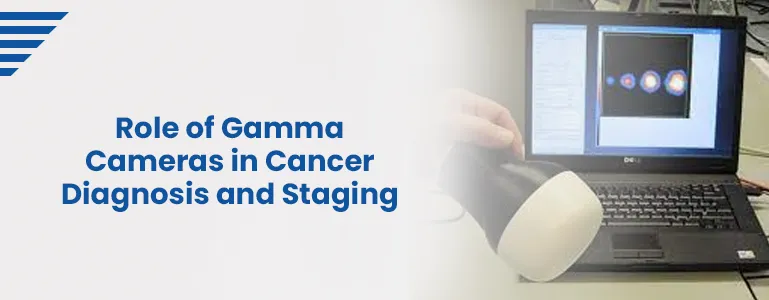Role of Gamma Cameras in Cancer Diagnosis and Staging

Gamma cameras have emerged as invaluable tools in the battle against cancer in medical imaging. These sophisticated devices play a pivotal role in diagnosing and staging various types of cancer. This blog will explore how gamma cameras transform cancer care by providing insights into tumour presence, activity, and progression.
Understanding Cancer Diagnosis and Staging:
Cancer diagnosis involves identifying malignant cells within the body, while staging focuses on determining the extent and severity of the disease. The accurate stage is crucial as it guides treatment decisions and predicts patient prognosis.
Home Sample Collection
How Gamma Cameras Work:
Gamma cameras are designed to detect gamma rays emitted by radioactive substances, known as radiotracers, that are introduced into the body. These radiotracers accumulate in specific tissues or organs, highlighting areas of interest. The camera then captures these emissions and transforms them into detailed images.
Gamma Cameras and Cancer Imaging:
Sentinel Lymph Node Mapping: Gamma cameras can be used to locate the sentinel lymph nodes, the first lymph nodes that cancer cells are most likely to go to. This information guides surgeons during biopsies and lymph node removal.
Bone Scintigraphy: Gamma cameras are instrumental in imaging bone metastases, helping clinicians identify whether cancer has spread to the bones. This is particularly crucial in breast, prostate, and lung cancers.
Thyroid Cancer: Gamma cameras assist in diagnosing and staging thyroid cancer by imaging the thyroid gland's function using radiotracers that target thyroid tissue.
Gastrointestinal Cancers: These cameras aid in evaluating gastrointestinal cancers by detecting abnormal tissue growth, assessing tumour activity, and identifying potential metastatic spread.
PET/CT Hybrid Imaging: Combining positron emission tomography (PET) and computed tomography (CT) scans with gamma cameras enhances imaging precision. Gamma cameras capture PET data, enabling a comprehensive view of tumour anatomy and metabolic activity.
Benefits of Gamma Camera Imaging in Cancer Care:
Early Detection: Gamma cameras can identify tumours early, increasing the chances of successful treatment.
Accurate Staging: By providing detailed insights into the extent of tumour spread, gamma cameras help stage cancer more accurately.
Treatment Guidance: Precise tumour imaging enables oncologists to tailor treatments like surgery, chemotherapy, or radiation therapy to individual patient needs.
Monitoring Response: Gamma cameras facilitate monitoring treatment response, aiding clinicians in adapting therapies based on changes in tumour activity.
Precautions and Patient Safety:
Gamma-camera operations are typically risk-free, however patients should be informed of any possible radiation exposure hazards. Healthcare professionals take strict precautions to ensure patient safety during imaging procedures.
Conclusion:
The role of gamma cameras in cancer diagnosis and staging is pivotal, enabling medical professionals to make informed decisions about patient care. By providing detailed images of tumour presence, activity, and extent, gamma cameras significantly enhance treatment outcomes and improve patient lives in the fight against cancer.
Frequently Asked Questions
What is the role of gamma cameras in cancer diagnosis?
Gamma cameras play a vital role in cancer diagnosis by detecting and imaging radioactive radiotracers accumulating in cancerous tissues. This helps identify the presence of malignant cells within the body.
How do gamma cameras aid in cancer staging?
Gamma cameras assist cancer staging by providing detailed images of tumour extent and spread. Oncologists can use this information to assess the disease's severity and develop effective treatment plans.
Which cancers can be diagnosed and staged using gamma cameras?
Gamma cameras diagnose and produce various types of cancer, including breast, prostate, lung, thyroid, gastrointestinal, and bone cancers.
What is sentinel lymph node mapping, and how do gamma cameras help?
The first lymph nodes that cancer cells are likely to disseminate to are identified by sentinel lymph node mapping. Gamma cameras locate these nodes, aiding surgeons in accurate lymph node removal during biopsies or surgeries.
What is bone scintigraphy, and how does it relate to cancer imaging?
Bone scintigraphy, facilitated by gamma cameras, involves imaging bone tissue using radiotracers. This helps identify bone metastases in cancers, such as breast, prostate, and lung cancers, by highlighting abnormal bone activity.
Can gamma cameras be used to evaluate thyroid cancer?
Yes, gamma cameras are used to image the thyroid gland's function and identify abnormalities in cases of thyroid cancer. Radiotracers targeting thyroid tissue aid in diagnosis and staging.
How does PET/CT hybrid imaging enhance cancer imaging?
PET/CT hybrid imaging combines positron emission tomography (PET) and computed tomography (CT) scans with gamma cameras. Gamma cameras capture PET data, providing comprehensive information about tumour anatomy and metabolic activity.
Are there any risks associated with gamma camera procedures?
While gamma-camera procedures are generally safe, they involve radiation exposure. Healthcare professionals take precautions to minimize risks, and the benefits of accurate cancer diagnosis and staging usually outweigh potential risks.
Can gamma cameras monitor treatment response in cancer patients?
Yes, gamma cameras facilitate monitoring treatment response by tracking changes in tumour activity. This enables oncologists to modify treatment plans based on observed responses.
How do gamma cameras contribute to personalized cancer treatment?
Gamma cameras provide detailed information about tumours' location, size, and activity. This information guides oncologists in tailoring treatments to individual patients' needs, increasing the chances of successful outcomes.
Book Your Slot
Our Locations Near You in Hyderabad
3KM from Banjara Hills
1.9KM from Yusufguda
3KM from Madhura Nagar
5KM from Shaikpet
Profiles
- Cardiac Risk Profile
- Pituitary marker Profile
- Rheumatoid Arthritis Profile
- Dengue Fever Panel
- Lung Cancer Panel 1 Complete Molecular
- Gastroenteritis Screening Panel
- Thyroid Profile (T3,T4,TSH), Serum
- Pancreatic Marker Profile
- STD profile
- Androgen Profile
- Lipid Profile, Serum
- Pancreatic(acute)Profile
- PCOD Profile
Radiology
Pathology Tests
- Glucose Fasting (FBS),Sodium Fluoride Plasma
- Creatinine, Serum
- Glycosylated Hemoglobin (HbA1C)
- Vitamin B12 (Cyanocobalamin), Serum
- Thyroid Stimulating Hormone (TSH) Ultrasensitive, Serum
- Complete Urine Examination (CUE), Urine
- Liver Function Test (LFT),Serum
- Dengue (IgG & IgM), Serum
- Dengue Antigen (Ns1) Rapid, Serum
- C-Reactive Protein (CRP), Serum
- Widal (Slide Method), Serum
- Total IgE, Serum




